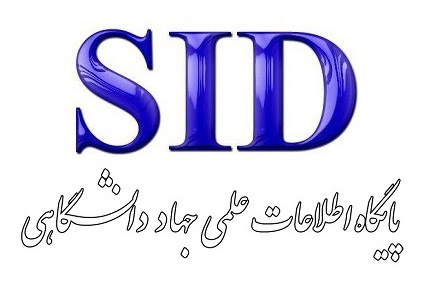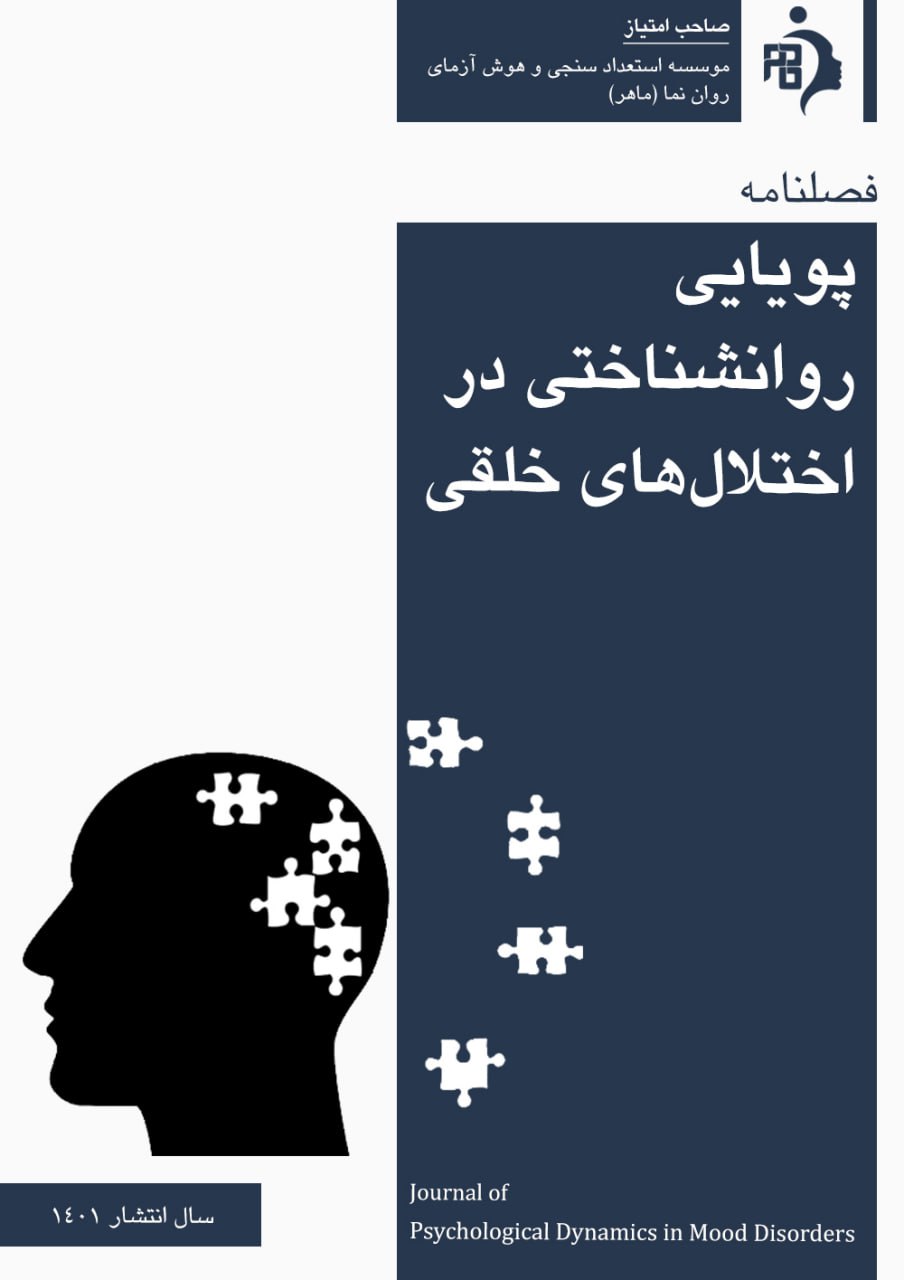پیشبینی نگرانی از تصویر بدن بر اساس همجوشی شناختی با نقش میانجی اجتناب تجربهای
کلمات کلیدی:
همجوشی شناختی, اجتناب تجربهای, نگرانی از تصویر بدن, دانشآموزان مقطع متوسطه, کرجچکیده
هدف: هدف این پژوهش بررسی نقش همجوشی شناختی در پیشبینی نگرانی از تصویر بدن با در نظر گرفتن نقش میانجی اجتناب تجربهای در دانشآموزان دختر مقطع متوسطه شهر کرج بود. روششناسی: این پژوهش کاربردی به روش پیمایشی و با رویکرد کمی انجام شد. جامعه آماری شامل کلیه دانشآموزان دختر مقطع متوسطه شهر کرج در سال تحصیلی ۱۴۰۳-۱۴۰۲ بود. حجم نمونه با استفاده از نرمافزار SPSS Sample Power برابر با ۳۵۷ نفر و به شیوه نمونهگیری خوشهای چندمرحلهای انتخاب شد. ابزار گردآوری دادهها شامل سه پرسشنامه استاندارد نگرانی از تصویر بدن، همجوشی شناختی، و پذیرش و عمل (نسخه دوم) بود. دادهها با استفاده از نرمافزار SPSS و مدلیابی معادلات ساختاری در AMOS تحلیل شدند. یافتهها: نتایج نشان داد که همجوشی شناختی بر نگرانی از تصویر بدن اثر مستقیم مثبت و معناداری دارد (β=0.53, p<0.001). همچنین، همجوشی شناختی بر اجتناب تجربهای نیز اثر مثبت و معنادار داشت (β=0.47, p<0.001) و اجتناب تجربهای به طور مستقیم نگرانی از تصویر بدن را پیشبینی کرد (β=0.50, p<0.001). آزمون بوتاسترپ نشان داد اجتناب تجربهای نقش میانجی جزئی بین همجوشی شناختی و نگرانی از تصویر بدن ایفا میکند (p=0.008). شاخصهای برازش مدل از جمله RMSEA=0.07 و CFI=0.91 مطلوب گزارش شد. نتیجهگیری: همجوشی شناختی و اجتناب تجربهای هر دو از عوامل مهم در تبیین نگرانی از تصویر بدن محسوب میشوند. نقش میانجی اجتناب تجربهای بیانگر آن است که کاهش اجتناب تجربهای میتواند شدت تأثیر همجوشی شناختی بر نگرانی از تصویر بدن را کاهش دهد. یافتهها میتوانند مبنای طراحی مداخلات شناختی-رفتاری موج سوم برای بهبود تصویر بدن در نوجوانان دختر باشند.
دانلودها
مراجع
Alessi, N., Coleman, H., & Rayner, G. (2023). Body image dissatisfaction: A novel predictor of poor quality of life in epilepsy. Epilepsy & Behavior, 141, 109149. https://doi.org/10.1016/j.yebeh.2023.109149
Alleva, J. M., Tylka, T. L., Martijn, C., Walden, M. I., & Webb, J. B. (2023). I'll never sacrifice me well-being again: The journey from negative to positive body image among women who perceive their body to deviate from societal norms. Body Image, 45, 153-171. https://doi.org/10.1016/j.bodyim.2023.03.001
Barney, J. L., Barrett, T. S., Lensegrav-Benson, T., Quakenbush, B., & Twohig, M. P. (2022). Examining a mediation model of body image-related cognitive fusion, intuitive eating, and eating disorder symptom severity in a clinical sample. Eating and Weight Disorders - Studies on Anorexia, Bulimia, and Obesity. https://doi.org/10.1007/s40519-021-01352-9
Brichacek, A. L., Murray, K., Neill, J. T., & Rieger, E. (2021). Contextual behavioral approaches to understanding body image threats and coping in youth: A qualitative study. Journal of Adolescent Research, 1-33. https://doi.org/10.1177/07435584211007851
Fang, S., Ding, D., Ji, P., Huang, M., & Hu, K. (2022). Cognitive Defusion and Psychological Flexibility Predict Negative Body Image in the Chinese College Students: Evidence from Acceptance and Commitment Therapy. International journal of environmental research and public health, 19, 16519. https://doi.org/10.3390/ijerph192416519
Fiuza, A., & Rodger, R. (2023). The effects of brief diet and anti-diet social media videos on body image and eating concerns among young women. Eating behaviors, 51, 101811. https://doi.org/10.1016/j.eatbeh.2023.101811
Grogan, S. (2021). Body image: Understanding body dissatisfaction in men, women and children. Routledge. https://www.taylorfrancis.com/books/mono/10.4324/9781003100041/body-image-sarah-grogan
Hollett, R. C., & Challis, M. (2023). Experimental evidence that browsing for activewear lowers explicit body image attitudes and implicit self-esteem in women. Body Image, 46, 383-394. https://www.sciencedirect.com/science/article/pii/S1740144523001018
Hu, Z., Yu, H., Zou, J., Zhang, Y., Lu, Z., & Hu, M. (2021). Relationship among self‐injury, experiential avoidance, cognitive fusion, anxiety, and depression in Chinese adolescent patients with nonsuicidal self‐injury. Brain and Behavior, 11(12), e2419. https://onlinelibrary.wiley.com/doi/abs/10.1002/brb3.2419
José Quintero, P. S., Rodríguez Biglieri, R., Etchezahar, E., & Gillanders, D. T. (2022). The Argentinian version of the cognitive fusion questionnaire: Psychometric properties and the role of cognitive fusion as a predictor of pathological worry. Current Psychology, 41(5), 2546-2557. https://link.springer.com/article/10.1007/s12144-020-00767-4
Linardon, J., Andeson, C., Messer, M., Rodgers, R. F., & Fuller-Tyszkiewicz, M. (2021). Body image flexibility and its correlates: A meta-analysis. Body Image, 37, 188-203. https://doi.org/10.1016/j.bodyim.2021.02.005
McComb, E. S., & Mills, J. S. (2021). Young women's body image following upwards comparison to Instagram models: The role of physical appearance perfectionism and cognitive emotion regulation. Body Image, 38, 49-62. https://doi.org/10.1016/j.bodyim.2021.03.012
Moran, O., Larsson, A., & McHugh, L. (2021). Investigating cognitive fusion, mindfulness and experiential avoidance in relation to psychosis-like symptoms in the general population. Journal of Contextual Behavioral Science, 21, 136-143. https://doi.org/10.1016/j.jcbs.2021.06.004
Paixão, C., Oliveira, S., & Ferreira, C. (2021). A comprehensive model of disordered eating among aesthetic athletic girls: Exploring the role of body image-related cognitive fusion and perfectionistic self-presentation. 40, 5727-5734. https://doi.org/10.1007/s12144-020-01142-z
Pehlivan, J. M., Shermanm, K., Wuthrich, V., Horn, M., Basson, M., & Duckworth, T. (2022). Body image and depression in endometriosis: Examining self-esteem and rumination as mediators. Body Image, 43, 463-473. https://doi.org/10.1016/j.bodyim.2022.10.012
Scardera, S., Sacco, S., Sante, J., & Booij, L. (2021). Body image-related cognitive fusion and disordered eating: the role of self-compassion and sad mood. Eating and Weight Disorders, 26(2), 483-490. https://doi.org/10.1007/s40519-020-00868-w
Servidio, R., Griffiths, M., Boca, S., & Demetrovics, Z. (2023). The serial mediation effects of body image-coping strategies and avatar-identification in the relationship between self-concept clarity and gaming disorder: A pilot study. Addictive Behaviors Reports, 17, 100482. https://doi.org/10.1016/j.abrep.2023.100482
Shahmohammadi, J., Mohagheghi, H., Farhadi, M., Yarmohammadi Vasal, M., & Zoghi Paydar, M. R. (2023). Experiential avoidance and body image concern in predicting positive attitude toward cosmetic surgery. Journal of Cognitive Psychology and Psychiatry, 10(1), 19-30. https://doi.org/10.32598/shenakht.10.1.19
Shirazi, F., Salehi, M., Hashemipour, F., & Karami, S. (2023). The role of cognitive emotion regulation, mindfulness, and cognitive fusion in predicting body image concern in women seeking cosmetic surgery. Journal of psychiatric nursing, 11(2), 52-63. http://ijpn.ir/browse.php?a_code=A-10-2120-2&slc_lang=fa&sid=1
Stojcic, I., Dong, X., & Ren, X. (2020). Body Image and Sociocultural Predictors of Body Image Dissatisfaction in Croatian and Chinese Women. Frontiers in psychology, 11, 731. https://doi.org/10.3389/fpsyg.2020.00731
Swami, V., Robinson, C., & Furnham, A. (2021). Associations between body image, social physique anxiety, and dating anxiety in heterosexual emerging adults. Body Image, 39, 305-312. https://doi.org/10.1016/j.bodyim.2021.10.004
Thomas, K. N., & Bardeen, J. R. (2020). The buffering effect of attentional control on the relationship between cognitive fusion and anxiety. Behaviour Research and Therapy, 132, 103653. https://doi.org/10.1016/j.brat.2020.103653
Yuan, W., Chen, L., Su, Y., Liu, J., Zhang, Y., Chen, M., Ma, Y., Guo, T., & Ma, J. (2023). Sleep time and quality associated with depression and social anxiety among children and adolescents aged 6-18 years, stratified by body composition. Journal of affective disorders, 338, 1321-1328. https://doi.org/10.1016/j.jad.2023.06.029
Zali, R., Esmaeili, A., & Saberi, H. (2022). The mediating role of cognitive flexibility styles in the relationship between anxiety and body image in women with breast cancer volunteering for mastectomy. Applied Family Therapy, 3(5), 567-580. https://doi.org/10.61838/kman.aftj.3.5.33
Zhang, C., Gangyan, X., Chung, P., Huang, Z., & Gucciardi, D. (2023). Examining the roles of experiential avoidance and cognitive fusion on the effects from mindfulness to athlete burnout: A longitudinal study. Psychology of Sport and Exercise, 64, 102341. https://doi.org/10.1016/j.psychsport.2022.102341
Zucchelli, F., White, P., & Williamson, H. (2020). Experiential avoidance and cognitive fusion mediate the relationship between body evaluation and unhelpful body image coping strategies in individuals with visible differences. Body Image, 32, 121-127. https://doi.org/10.1016/j.bodyim.2019.12.002
دانلود
چاپ شده
ارسال
بازنگری
پذیرش
شماره
نوع مقاله
مجوز
حق نشر 2025 هادی احمدی , داود تقوایی, محمدمهدی جهانگیری (Author)

این پروژه تحت مجوز بین المللی Creative Commons Attribution-NonCommercial 4.0 می باشد.









